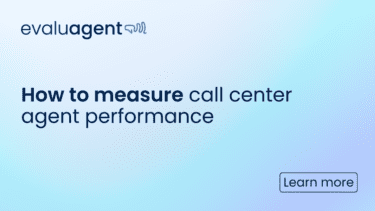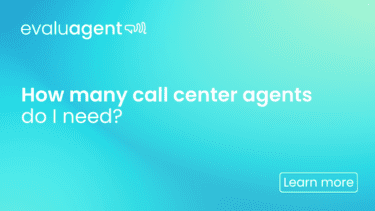One-to-ones are an essential but far too often overlooked part of the Quality Assurance and Performance Improvement Cycle.
One-to-one meetings between managers and employees are often one of those things that everyone agrees is important, but that get nixed during busy periods.
This article outlines why you should always make time for one-on-ones, even if it makes other workloads heavier in the short term. The long-term impact of cancelling your agents’ offline time to make up for a shortfall in service levels is far more drastic – you’ll end up with a workforce that feels undervalued, whilst given no chance to improve their skills.
As customers get more choosy, and organisations scramble to compete on CX, having well-trained and knowledgeable frontline agents will be a real advantage. To do this, you need to invest time and effort in developing your agents’ skills. One-to-one meetings are a vital part of this.
In fact, one-to-ones are so important to your contact centre’s success that EvaluAgent CEO Jaime recommends “only cancelling offline time if the call centre is on fire”.
Here’s what one-to-ones are, and why we think they’re so important.
What Are One-to-Ones?
A one-to-one meeting is a meeting between an agent and their direct line manager. This is expressly for the purpose of building rapport, coaching and both providing and receiving feedback.
For managers, one-to-ones are a vital opportunity to provide feedback on an employee’s performance and coach out problem behaviours, whilst recognising where the employee has done well. From the employee’s point of view these meetings are vital for improvement and progression, and are an opportunity to ask for what they need to progress.
Overall, one-to-ones build rapport within teams and, if carried out effectively and constructively, boost employee engagement significantly.
What Does This Mean For Contact Centre Performance?
In a nutshell, agents who feel engaged at work deliver better service. If you put the time in with one-to-ones, the quality of customer interactions will gradually increase.
Consider that:
- 70% of the variance in employee engagement across an organisation is caused by an employee’s manager (Gallup)
- Executives of large organisations estimate poor soft skills cost them over $144,500 each day (Harvard Business Review)
One-to-ones are a great way to address these key problem areas. As well as the coaching aspect, having a manager that is invested in agent performance is a great way to
There are many benefits to one-to-ones. We’ve broken them down into five key areas:
A Better Overall CX
Investing time in your agents improves their performance. As they work on the frontline of your business, that translates pretty directly into a vastly better CX for your customers.
Coaching your agents based on QA data and feedback from customers will result in a higher quality of customer interaction and a higher percentage of interactions resolved on first contact. You should see your chosen customer satisfaction metrics (for example CSAT or NPS) gradually increase over time to reflect this.
Increased Efficiency
Alongside the revenue-generating benefits of an improved CX (increased customer spend, greater customer lifetime value), coaching your agents via one-to-ones also allows you to decrease your operating costs. It’s a win-win.
This is largely due to efficiency gains – as your agents get better at responding to contacts, they can deal with more in the same amount of time. This means you need fewer agents to deal with the same number of contacts, and you can reinvest the time spent in more coaching, or dealing with complex interactions you might not have had the time to address properly otherwise.
Reduced Agent Attrition
If agents feel supported in their job via regular contact with their manager, they are less likely to leave. If you have a stable, established workforce, you’ll save significantly on hiring costs and drastically reduce the inefficiency of constantly onboarding new agents.
Agents who have been in their job for a long time also build up a bank of operational knowledge that helps them deliver great service. Keeping this inside your organisation will help you deliver a world-beating CX that keeps your customers coming back.
They Make Use of The Data From Your QA and Customer Feedback Processes
Gathering data takes time and money. You need to invest in the systems that collect and store it, pay a QA team to evaluate calls and constantly optimise your customer feedback journeys for more responses.
If you don’t act on this insight, you are wasting all the resources and effort you spend here. One-to-ones are by far the most effective way of presenting this feedback to agents in an approachable, useful and effective manner – use them to max out the value your customer and QA data offers.
One-to-Ones Build Rapport
Strong teams are the glue of your contact centre. Not only do they decrease agent turnover and increase employee engagement, they also facilitate communication, reduce conflict and enable agents and managers to solve issues in a supportive environment.
Regular one-to-ones with a are a two-way check in. They allow agents to communicate their own needs to their manager as much as allowing managers to offer feedback. This relationship builds rapport amongst teams, helping ensure your contact centre’s success in the long term.
Are You Looking To Make One-to-Ones More Impactful?
EvaluAgent has everything you need to improve the performance of your frontline teams.
One-to-Ones and Actions, our newly-released performance improvement tool, facilitates data-driven, action-focused meetings and coaching sessions for both managers and agents.
Your managers can now schedule and complete meetings focused on topics, feedback or performance data from EvaluAgent’s reporting suite. Connected workflows ensure that everyone stays clear on the meeting’s focus, whilst configurable meeting templates help coaches document the conversation and any follow-up actions.
Agents can fully interact with meetings and actions, and as a result play a more proactive role in their own performance improvement. Meanwhile, leaders always have visibility over quality and quantity of coaching, with the ability to track actions for further insight.
This more accessible and empowering approach to performance management leads to higher levels of agent engagement across the contact centre. This contributes to increasing efficiency and business performance on a wider level, whilst reducing employee churn.




